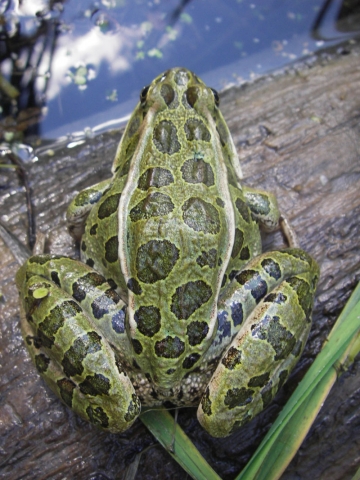Nature Conservancy of Canada allows frogs and bears to feel safe in Creston Valley
The Nature Conservancy of Canada (NCC) is doing its best to preserve wildlife in and around the Creston Valley after purchasing 306 acres (124 hectares) that are frequented by an at‐risk population of grizzly bears as they move between the Selkirk and Purcell mountains.
“Protecting this land in the valley bottom is vitally important for the long‐term prospects of the South Selkirk grizzly bear population,” said Nancy Newhouse, Canadian Rockies Program Manager for the Nature Conservancy of Canada in a written release.
“These lands are also incredibly important for agriculture. The Nature
Conservancy of Canada is proud to be able to work hand in hand with local producers to protect both wildlife habitat and our farming heritage.”
The NCC made the purchase from Creston‐based Wynndel Box and Lumber.
The two properties are adjacent to Duck Lake in the Creston Valley Wildlife Management Area.
Agricultural activity will continue on a portion of the land, at the same time as conservation measures are taken to safeguard at-risk plants and animals.
The project is named Frog‐Bear Conservation Area in honour of two of the key species that will benefit from its conservation.
The total cost of the project is $1.1 million, which includes an endowment fund to enable long‐term stewardship of the properties.
The Yellowstone to Yukon Conservation Initiative (Y2Y) played a critical role in this project. The joint US/Canada organization works to ensure that wild animals are able to move through and around human communities and activities within the 1.3Mkm2 Yellowstone to Yukon region. Y2Y not only provided half the purchase funds for the property, but also helped fund the research that identified the significance of this parcel.
“We are pleased to have come together with NCC to buy this land at Duck Lake, which is critical for the survival of large mammals and amphibians. Highway 3 is the most important area to ensure wildlife connectivity is preserved in the entire Yellowstone to Yukon region,” said Harvey Locke, Y2Y Strategic Advisor.
Both organizations rely on scientific data to inform conservation decisions, and in this case the research shows very clearly that the Creston Valley contains critical habitat for not just grizzly bears and northern leopard frogs, but many other migratory and resident species as well.
“Grizzly bears are what we call an umbrella species, meaning their range is so large that it overlaps the habitat of many other species,” said Michael Proctor, grizzly bear biologist and lead researcher of the Trans‐border Grizzly Bear Project.
“Through habitat modelling we identify where bears will most likely
travel through the valley, which then guides our conservation efforts to the highest value habitat for bears and, by default, many other creatures.”
Additional funding for the project came from the Fish and Wildlife Compensation Program, the US Fish and Wildlife Service, the Donner Canadian Foundation, Wilburforce Foundation and other private donors.
“Over the years the Compensation Program has worked hard to help many species in the Creston Valley, including grizzly bears, herons, ospreys, swifts, bats and western skinks,” said FWCP program manager in the Columbia region, Trevor Oussoren. “Therefore we are very happy to be one of the partners in supporting the purchase of the Frog Bear property as we understand the true value of acquiring, and managing, conservation properties to maintain and increase wildlife values.”
The Nature Conservancy of Canada (NCC) is the nation’s leading not‐for‐profit private land conservation organization, working to protect our most important natural areas and the species they sustain. Since
1962 NCC and its partners have helped to protect more than 2 million acres (800,000 hectares) coast to coast. To learn more visit: www.natureconservancy.ca.
Facts
· The conservation project helps to connect the isolated South Selkirk grizzly bear population with other bear populations to the east and south.
· Several rare species have been documented in the Creston Valley, including the northern leopard frog, northern rubber boa, great blue heron, American bittern and western screech‐owl.
· The properties provide key links between aquatic and terrestrial habitats.
· The wetlands provide vital movement corridors for migratory birds, reptiles and amphibians.



























Comments